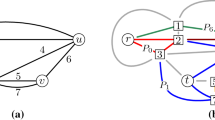Abstract
Partially ordered sets of small width and graphs of small Dilworth number have many interesting properties and have been well studied. Here we show that recognition of such orders and graphs can be done more efficiently than by using the well-known algorithms based on bipartite matching and matrix multiplication. In particular, we show that deciding deciding if an order has width k can be done in O(kn 2) time and whether a graph has Dilworth number k can be done in O(k 2 n 2) time.
For very small k we have even better results. We show that orders of width at most 3 can be recognized in O(n) time and of width at most 4 in O(nlog n).
Similar content being viewed by others
References
Arlazarov, V. L., Dinic, E. A., Kronrod, M. A. and Faradzev, I. A.: On economical construction of the transitive closure of a directed graph, Soviet Math.Dokl. 11 (1970), 1209–1210.
Alt, H., Blum, N., Mehlhorn, K. and Paul, M.: Computing a maximum cardinality matching in a bipartite graph in time O n 1.5 (m/log n)0.5 ), Inf.Proc.Lett. 37 (1991), 237–240.
Atkinson, M. D. and Chang, H. W.: Linear extensions of posets of bounded width, Congressus Numerantium 52 (1986), 21–35.
Benzaken, C., Hammer, P. L. and de Werra, D.: Threshold characterization of graphs with Dilworth number 2, J.Graph Theory 9 (1985), 245–267
Benzaken, C., Hammer, P. L. and de Werra, D.: Split graphs of Dilworth number two, Discrete Math. 55 (1985), 123–128.
Bondy, J. A. and Murty, U. S. R.: Graph Theory with Applications, Elsevier, New York/Macmillan, London, 1976.
Cheriyan, J.: Randomized O(M(|V|)) algorithms for problems in matching theory, SIAM J.Comput. 26 (1997), 1635–1655.
Chvátal, V. and Hammer, P. L.: Set-packing and threshold graphs, University of Waterloo Research Report CORR73–21, 1973.
Chvátal, V. and Hammer, P. L.: Aggregation of inequalities in integer programming, Ann.Discrete Math. 1 (1977), 145–162.
Colbourn, C. J. and Pulleyblank, W. R.: Minimizing setups in ordered sets of fixed width, Order 1 (1985), 225–228.
Gormen, T. H., Leiserson, C. E. and Rivest, R. L.: Introduction to Algorithms, MIT Press, 1990.
Coppersmith, D. and Winograd, S.: Matrix multiplication via arithmetic progressions, J.Symbolic Comput. 9 (1990), 251–280.
Dilworth, R. P.: A decomposition theorem for partially ordered sets, Ann.Math. 51 (1950), 161–166. 14. Dilworth, R. P.: Some combinatorial problems on partially ordered sets, In: Bellman and Hall (eds), Combinatorial Analysis, Proc. Sympos. Appl. Math. 10, 1960, pp. 85–90.
Földes, S. and Hammer, P. L.: The Dilworth number of a graph, Ann.Discrete Math. 2 (1978), 211–219.
Fulkerson, D. R.: Note on Dilworth's embedding theorem for partially ordered sets, Proc.Amer.Math.Soc. 7 (1956), 701–702.
Gavril, F.: Algorithms for maximum k-colorings and k-coverings of transitive graphs, Networks 17 (1987), 465–470.
Golumbic, M. C.: Algorithmic Graph Theory and Perfect Graphs, Academic Press, New York, 1980.
Gorgos, I. M.: Characterization of quasitriangulated graphs, Technical Report, University of Kishinev, 1982.
Hoàng, C. T. and Mahadev, N. V. R.: A note on perfect orders, Discrete Math. 74 (1989), 77–84.
Hopcroft, J. E. and Karp, R. M.: A n 5/2 algorithm for maximum matchings in bipartite graphs, SIAM J.Comput. 2 (1973), 225–231.
Mahadev, N. V. R. and Peled, U. N.: Threshold graphs and related topics, Ann.Discrete Math. 56 (1995).
McConnell, R. and Spinrad, J.: Linear time transitive orientation, In: ACM-SIAM Symposium on Discrete Algorithms, 1997, pp. 19–25.
Pappadimitriou, C. H. and Yannakakis, M. Scheduling interval ordered tasks, SIAM J.Comput. 8 (1979), 405–409.
Payan, C.: Perfectness and Dilworth number, Discrete Math. 44 (1983), 229–230.
Raghavan, V. and Tripathi, A.: Improved diagnosability algorithms, IEEE Trans.Comput. 2 (1991), 143–153.
Sidney, J. B. and Steiner, G.: Optimal sequencing by modular decomposition: Polynomial algorithms, Oper.Res. 34 (1986), 606–612.
Steiner, G.: Polynomial algorithms to count linear extensions in certain posets, Congressus Numerantium 75 (1990), 71–90.
Strassen, V.: Gaussian elimination is not optimal, Numer.Math. 13 (1969), 354–356.
Tarjan, R.E.:Data Structures and Network Algorithms, CBMS Series 44, SIAM, Philadelphia, 1983.
van Emde Boas, P.: Preserving order in a forest in less than logarithmic time and linear space, Inform.Process.Lett. 6 (1977), 80–82.
Author information
Authors and Affiliations
Rights and permissions
About this article
Cite this article
Felsner, S., Raghavan, V. & Spinrad, J. Recognition Algorithms for Orders of Small Width and Graphs of Small Dilworth Number. Order 20, 351–364 (2003). https://doi.org/10.1023/B:ORDE.0000034609.99940.fb
Issue Date:
DOI: https://doi.org/10.1023/B:ORDE.0000034609.99940.fb




